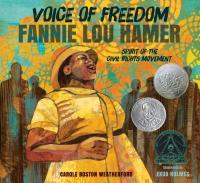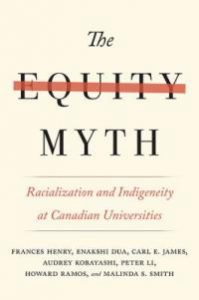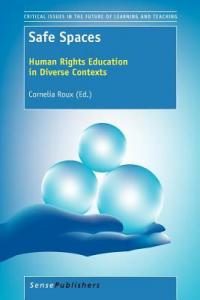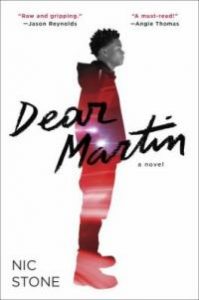Human rights is a term that is familiar to many, but it is also a term that has many different facets. Education is a key part of exploring these facets of human rights, whether specifically within the education field or teaching about human rights. This month’s lobby display is a curated mix on both different human rights issues, and human rights in education.
Voice of Freedom: Fannie Lou Hamer by Carole Boston Weatherford and illustrated by Ekua Holmes

Fannie Lou Hamer was at the forefront of the American civil rights movement. This beautifully illustrated book tells the story of her life and work with the movement. Hamer used her voice to inspire black youth into fighting for equal rights and was given the name of “the spirit of the civil rights movement.” She went on to run for Congress, and to meet Dr Martin Luther King Jr. Despite its fantastic illustrations, this book does not shy away from the brutality of the fight for equal rights for African-Americans, and vividly describes the horrors committed against those advocating for equal opportunities. Given the occasional graphic descriptions, visuals, and language, this book would be best suited for teachers wishing to introduce to this topic to older elementary school students.
The Equity Myth: Racialization and Indigeneity at Canadian University by Frances Henry, Enakshi Dua, Carl E. James, Audrey Kobayashi, Peter Li, Howard Ramos, and Malinda S. Smith

Universities are exalted as places of liberalness, whether in thought, speech, or action. However, what is often ignored is the whiteness of universities, whether it be in terms of curriculum or faculty. Despite the growth in policies to promote diversity, the diversity of academic faculty has not increased proportionately. This book takes an in-depth look at the experiences of racialized and Indigenous faculty members through examining several aspects of racialization and Indigeneity, such as: representational diversity, institutional and organizational factors, and mechanisms for inclusion of racialized and Indigenous scholars like policies and practices. Additionally, a sample of 89 scholars from various institutions were interviewed on their experiences as racialized and Indigenous faculty members. The findings of these interviews was that no two interviewees had the same experiences, but the overall conclusions drawn were that racialized and Indigenous faculty members are numerically underrepresented and they experience racism in many forms: personal and structural, both explicit and extremely subtle.
Teachers and Human Rights Education by Audrey Osler and Hugh Starkey
 This book explores how teachers are at the forefront of human rights education, and how that role can inspire a new generation to be activists and empowered citizens. When children are taught in an environment where they experience equality, fairness, dignity, and inclusion, teachers contribute to a more just tomorrow. The authors have used international examples to demonstrate how schools can work with young people to promote the importance of human rights. This volume is divided into three sections: Human Rights: An Agenda for Action; Politics, Cultures and Inequalities; and Human Rights and Democracy in Schools.
This book explores how teachers are at the forefront of human rights education, and how that role can inspire a new generation to be activists and empowered citizens. When children are taught in an environment where they experience equality, fairness, dignity, and inclusion, teachers contribute to a more just tomorrow. The authors have used international examples to demonstrate how schools can work with young people to promote the importance of human rights. This volume is divided into three sections: Human Rights: An Agenda for Action; Politics, Cultures and Inequalities; and Human Rights and Democracy in Schools.
Safe Spaces: Human Rights Education in Diverse Contexts edited by Cornelia Roux

Human rights education is an incredibly important part of education as a whole. This book aims, through diverse perspectives, to offer a holistic approach to this topic in a constantly changing world. The diversity in perspectives is of course topic-based, but also experience-based. Novice researchers, developing researchers, and established researchers have all contributed to the chapters in Safe Spaces. Among others, this book features chapters on topics such as: Discourse, Betrayal, Critique: The Renewal of Human Rights Education; Girls’ Experiences of Religious and Cultural Practices: Human Rights Violations; and Plurality in Society Mirrored in the Teacher’s Multivoices Self – Internalized Inequality.
Dear Martin by Nic Stone
 This novel is told by the same person, but through two methods: third person prose, and first-person letter writing. The bulk of the story is told in third person, but every few chapters, the main character writes a letter to Dr Martin Luther King Jr (on whom he did a project in tenth grade) that describes events in first person. Justyce McAllister is a teenage black boy attending a prestigious private preparatory school on full scholarship, and after events transpire that see Justyce in handcuffs for no reason, he starts to take more notice of the racial discrimination he encounters and speaking out against them, to the chagrin of those around him. These inequalities come to a boiling point after a tragic shooting, and Justyce must learn how to navigate the aftermath. Dear Martin is an incredible read for those in intermediate elementary grades and high school who are studying racial discrimination, civil rights, and activist movements.
This novel is told by the same person, but through two methods: third person prose, and first-person letter writing. The bulk of the story is told in third person, but every few chapters, the main character writes a letter to Dr Martin Luther King Jr (on whom he did a project in tenth grade) that describes events in first person. Justyce McAllister is a teenage black boy attending a prestigious private preparatory school on full scholarship, and after events transpire that see Justyce in handcuffs for no reason, he starts to take more notice of the racial discrimination he encounters and speaking out against them, to the chagrin of those around him. These inequalities come to a boiling point after a tragic shooting, and Justyce must learn how to navigate the aftermath. Dear Martin is an incredible read for those in intermediate elementary grades and high school who are studying racial discrimination, civil rights, and activist movements.
To browse and borrow these books, please visit the OISE Lobby Display on the ground floor of the OISE building.
